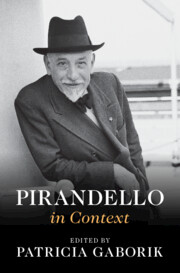Book contents
- Pirandello in Context
- Pirandello in Context
- Copyright page
- Dedication
- Contents
- Figures
- Contributors
- Preface
- Acknowledgments
- Chronology
- List of Cited Titles in Translation and the Original Italian
- Part I Places
- Part II Institutions
- Part III Interlocutors
- Part IV Traditions and Trends, Techniques and Forms
- Part V Culture and Society
- Chapter 25 History
- Chapter 26 Celebrity
- Chapter 27 Cinema
- Chapter 28 Modernity
- Chapter 29 Fascism
- Chapter 30 Women
- Chapter 31 Religion
- Chapter 32 Madness
- Chapter 33 Suicide
- Part VI Reception and Legacy
- Further Reading
- Index
Chapter 33 - Suicide
from Part V - Culture and Society
Published online by Cambridge University Press: 14 March 2024
- Pirandello in Context
- Pirandello in Context
- Copyright page
- Dedication
- Contents
- Figures
- Contributors
- Preface
- Acknowledgments
- Chronology
- List of Cited Titles in Translation and the Original Italian
- Part I Places
- Part II Institutions
- Part III Interlocutors
- Part IV Traditions and Trends, Techniques and Forms
- Part V Culture and Society
- Chapter 25 History
- Chapter 26 Celebrity
- Chapter 27 Cinema
- Chapter 28 Modernity
- Chapter 29 Fascism
- Chapter 30 Women
- Chapter 31 Religion
- Chapter 32 Madness
- Chapter 33 Suicide
- Part VI Reception and Legacy
- Further Reading
- Index
Summary
This chapter examines works of Pirandello that feature the act of suicide against the backdrop of a historical epoch in which the issue of taking one’s own life was critical and culturally charged. Some of the suicides of the age were heroic self-immolators, as Carlo Michelstaedter appeared to many to be. Some were simply in desperate existential straits. Still others were women suffering intolerably in erotic relationships. The last two groups abound in Pirandello’s literary fictions, and he shares deep sympathy for them in approximately two dozen stories, many of which are analyzed closely here for their ethical and philosophical implications. Even more interesting “Pirandellian suicides” are symbolic ones, like Vitangelo Moscarda and Mattia Pascal in the novels. These characters reject, but do not end, the lives they have known before the narratives take their turns, producing the radical vitality of a non-life by bourgeois standards.
Keywords
- Type
- Chapter
- Information
- Pirandello in Context , pp. 266 - 272Publisher: Cambridge University PressPrint publication year: 2024

